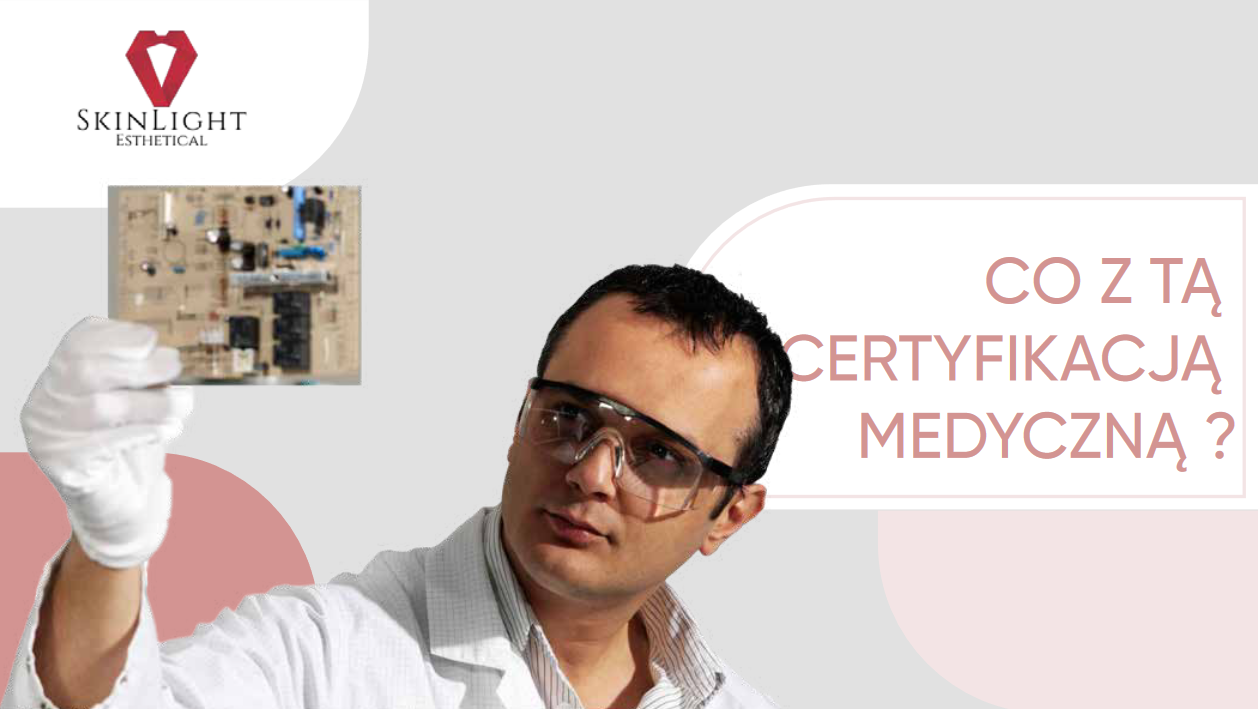“SkinLight Esthetical: Leading Innovations in the Med & Beauty Industry with ISO 13485 Standard”
In recent years, the medical and aesthetic industry has experienced significant growth, leading to innovations in technology and increasing interest in high-quality medical and beauty equipment. In response to the growing market demands, the distributor of medical and aesthetic equipment – SkinLight Esthetical, proudly announces the importation of equipment in accordance with the ISO 13485 standard. This international standard emphasizes the quality management system requirements for manufacturers of medical devices, ensuring their safety and effectiveness.
The ISO 13485 standard focuses on ensuring that medical devices comply with established international regulations and quality standards. It encompasses a range of processes and procedures aimed at minimizing the risks associated with medical devices – from the design phase to distribution.
At SkinLight Esthetical, the priority is to provide equipment that not only meets but exceeds customer expectations and industry regulations. By importing equipment compliant with ISO 13485, SkinLight Esthetical is committed to ensuring that its product offerings are safe, effective, and meet the highest quality standards. This allows customers to be confident that they are receiving products that have undergone rigorous quality control processes before entering the market.
Although the Medical Device Regulation (MDR) in the European Union introduces additional layers of requirements for medical devices, ISO 13485 certification is a solid step towards meeting these requirements, facilitating the compliance process, and enabling SkinLight Esthetical to continue providing innovative solutions to its customers.
In pursuit of continuous improvement and commitment to quality, SkinLight Esthetical is excited about the opportunity to offer even better products and services to its customers. This commitment to ISO 13485 standards demonstrates that SkinLight Esthetical is a leader in the industry, constantly striving to improve the quality and safety of its products to meet the growing demands of the medical and aesthetic market.
With this approach, SkinLight Esthetical continues its mission to provide customers with the highest quality medical and aesthetic equipment, allowing for the implementation of cutting-edge procedures and technologies in the Med & Beauty industry.
What about 2024?
The Medical Device Regulation (MDR) introduces a range of new requirements for manufacturers of medical devices in the European Union, which also has implications for products certified with ISO 13485. Here are some of the consequences:
- Quality Management System (QMS) Requirements:
- The MDR regulation requires manufacturers of medical devices to implement a comprehensive quality management system (QMS). Although ISO 13485 certification is not required to meet MDR requirements, it can significantly help demonstrate compliance with these requirements, as MDR requires the implementation of a QMS, and ISO 13485 certification can be used to demonstrate compliance with this requirement.
- Documentation:
- MDR introduces additional documentation requirements that must be provided to comply with EU regulations. For example, while ISO 13485 requires maintaining a medical device file, MDR requires this documentation to contain all the information specified in Annex II of the MDR regarding the technical documentation of the medical device. In addition, MDR requires additional records regarding post-market surveillance and clinical evaluation. The processes of creating, updating, and maintaining this documentation will remain largely unchanged.
- Supplier Audits:
- Both MDR and ISO 13485 require regular supplier audits. Integrating MDR requirements into ISO 13485 audits is a common way to verify suppliers’ compliance with both standards.
- International Standards:
- MDR and ISO 13485 play crucial roles in ensuring the safety, quality, and effectiveness of medical devices. MDR regulates the production, marketing, and distribution of medical devices in the European Union, while ISO 13485 is an international standard for creating QMS for medical companies worldwide.
- Scope and Detail:
- The introduction of MDR as of May 26, 2020, replaces the previous MDD/AIMD certificates and presents an expansion of both the scope and detail of requirements compared to ISO 13485.
The impact of MDR regulations on products certified with ISO 13485 thus covers a range of areas, each of which may require different levels of adaptation from manufacturers of medical devices.
What about the Beauty industry?
ISO 13485 certification is important for organizations producing medical devices, which also affects the beauty industry, especially in the context of devices used in aesthetic procedures. Here are a few benefits that ISO 13485 certification can bring:
- Improved Product Quality and Safety:
- With a quality management system (QMS) in place, your organization can produce reliable medical devices without the risk of product recalls or lawsuits. The fundamental principle of ISO 13485 is continuous improvement, which, combined with greater employee engagement, allows for improved product quality and safety.
- International Recognition:
- ISO 13485 certification leads to international recognition, especially in major global markets, which can be beneficial for companies operating in the beauty industry, expanding their reach to international markets.
- Legal Compliance:
- It helps maintain compliance with local legal regulations, which may be important for beauty industry companies that manufacture or distribute medical devices.
- Reduction of Process Redundancy:
- It contributes to minimizing process redundancy, which can lead to increased operational efficiency and cost savings.
- Brand Reputation Enhancement:
- It shows potential customers that your company is committed to excellence in quality management practices and producing safe products, which is attractive to consumers and can contribute to a positive brand image in the beauty industry.
- Increasing Profitability:
- It can lead to increased profit margins through more efficient quality management and compliance with international industry standards.
In the context of the beauty industry, where some products and services may be classified as medical devices, ISO 13485 certification can bring added value through improved quality, safety, and brand reputation, as well as increased access to international markets.
Will my product lose its medical certification on May 27, 2024?
The Medical Devices Regulation (MDR) (EU) 2017/745, which came into force on May 26, 2021, has introduced significant changes to the regulatory framework for medical devices in the European Union (EU). This regulation has implications for the beauty industry, especially those dealing with aesthetic medical devices. Here are a few key points and consequences for the beauty industry based on the MDR 2017/745 regulation and provided information:
- Regulation of Aesthetic Devices:
- Although the term “aesthetic” is not explicitly included in the definition of medical devices (MD), most aesthetic devices are regulated as MD by regional authorities based on their technical specifications and intended use, especially for high-risk devices and high-class products.
- Expiry of Current Certificates:
- The MDR states that devices with valid certificates issued under the previous Medical Devices Directive 93/42/EEC (MDD) may continue to be placed on the market or put into service until May 26, 2024. This indicates that a significant number of currently valid certificates will expire by 2024, requiring recertification according to the new MDR guidelines.
- Challenges for Manufacturers:
- The new regulations pose significant challenges for manufacturers, distributors, and importers, requiring compliance with updated regulations. These challenges also include the beauty industry, especially companies dealing with aesthetic medical devices.
- Impact on Suppliers:
- Suppliers of medical devices, including many products used in the beauty and dermatology sectors, will experience significant effects due to the new MDR regulation.
- Operational Failures and Costs:
- The MDR has drawn attention to operational failures across the industry and puts pressure on companies to modernize their processes and systems. Transitioning to MDR compliance can be costly for device manufacturers, indirectly impacting the beauty industry if it leads to increased costs or delays for aesthetic medical devices.
- Clinical Data Requirements:
- One of the significant challenges is the requirement for more extensive clinical data to support successful compliance assessment or certification processes under the MDR, as opposed to the previous MDD requirements.
- Preparation for MDR Compliance:
- Entities in the beauty industry must ensure timely adaptation to the new MDR regulations to avoid disruptions, especially as the expiration date of current certificates approaches.
The points mentioned emphasize the need for adaptation by entities in the beauty industry to the new regulatory landscape to ensure compliance and continuous access to the market for their products within the EU.
ISO and MDR?
While ISO 13485 certification can significantly contribute to meeting the requirements specified in the Medical Device Regulation (MDR), it does not guarantee full compliance with MDR on its own. Here are a few key points to note:
- Extended Documentation Requirements:
– The MDR introduces additional documentation requirements compared to ISO 13485. For example, while ISO 13485 requires maintaining a medical device file, the MDR requires this documentation to contain all information specified in Annex II of the MDR regarding the technical documentation of the medical device, as well as additional records regarding post-market surveillance and clinical evaluation. [ISO 13485: How can it help with MDR compliance?](https://advisera.com/13485academy/blog/2020/03/09/how-can-iso-13485-help-with-mdr-compliance/).
- Adjustment of Quality Management System:
– Although a quality management system (QMS) compliant with ISO 13485 can provide a solid foundation, the MDR may require additional adjustments to the QMS to meet all its requirements. Some processes or procedures may require updates or additional documentation.
- Compliance with Local Legal Requirements:
– The MDR is a specific set of legal regulations for medical devices in the EU. If beauty products are classified as medical devices, they must comply with these regulations to be placed on the market in the EU. ISO 13485 certification can help demonstrate compliance with some of these requirements, but additional steps or documentation may be required to fully meet the MDR.
- Harmonization of Standards:
– Although ISO 13485 is not directly mentioned in the MDR, it is the only QMS standard listed on the EU’s list of harmonized standards, making it the only reasonable way to implement a QMS in accordance with the MDR. [ISO 13485: How can it help with MDR compliance?](https://advisera.com/13485academy/blog/2020/03/09/how-can-iso-13485-help-with-mdr-compliance/).
In summary, ISO 13485 certification can be an important step towards MDR compliance, but manufacturers should fully understand the additional requirements of the MDR and be prepared to take additional steps to fully meet these regulations.


